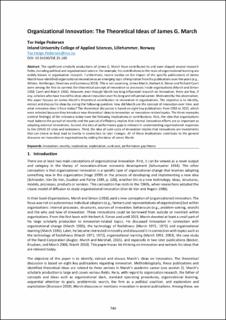| dc.description.abstract | The significant scholarly productions of James G. March have contributed to and even shaped several research fields, including political and organizational science. For example, his contributions to the topic of organizational learning are widely known in organization research. Furthermore, recent studies on the impact of the specific publications of James March have identified organizational innovation as an emerging topic of inspiration from his publications over the years (e.g., Wilden, Hohlberger, Devinney and Lumineau 2019). This is not surprising. James March, Herbert A. Simon and Richard Cyert were among the first to connect the theoretical concept of innovation to processes inside organizations (March and Simon 1958; Cyert and March 1963). However, even though March has long influenced research on innovation, there are few, if any, scholars who have traced his ideas about innovation over his long and influential career. Motivated by this observation, this paper focuses on James March’s theoretical contribution to innovation in organizations. The objective is to identify, extract and discuss his ideas by asking the following question: how did March use the concept of innovation over time, and what relevance does it have today? The theoretical discussion is based on eight key publications from 1958 to 2015, which were selected because they introduce new theoretical ideas to innovation or innovation-related topics. The three examples (central findings) of the relevance today have the following implications or contributions. First, the idea that organizations must balance the pursuit of novelty and the pursuit of efficiency implies that internal innovation efforts are as important as adopting external innovations. Second, the idea of performance gaps is relevant in understanding organizational responses to the COVID-19 crisis and lockdowns. Third, the idea of sunk costs of innovation implies that innovations are investments that can (more or less) lead to inertia in connection to later changes. All of these implications contribute to the general discourse on innovation in organizations by adding the ideas of James March. | en_US |
